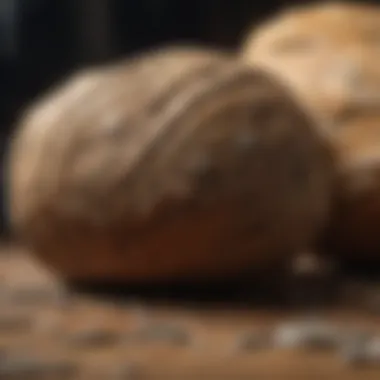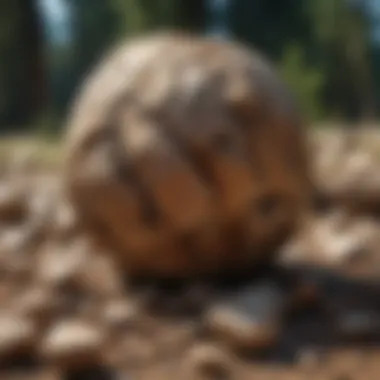Unlocking the Advantages of Wood Tumbling Media for Rock and Fossil Collection Enthusiasts


Rock and Fossil Identification
In the realm of rock and fossil collection, a crucial initial step resides in the identification process. Understanding the types of rocks and fossils one may encounter is essential to discern their characteristics and value. Diverse types of rocks include igneous, sedimentary, and metamorphic, each showcasing distinct properties derived from their formation process. Fossils, on the other hand, offer glimpses into ancient life forms through imprints, casts, or petrified remains. To effectively identify these specimens, collectors should hone their observation skills to recognize key features that indicate a specimen's geological origin and historical significance.
When it comes to tools for identification, a collector's toolkit must be equipped with essentials like magnifying glasses, UV lights, and hardness testing kits. Magnifying glasses aid in examining minute details, UV lights reveal fluorescent properties in certain rocks and minerals, while hardness testing kits help determine the durability of specimens. By leveraging these tools, collectors enhance their ability to identify rocks and fossils with precision and insight.
Collecting Tips and Techniques
Venturing into the outdoors to collect rocks and fossils requires a strategic approach to ensure fruitful outcomes. Best practices for collecting involve researching prime locations known for their geological diversity and fossil richness. Locating prime collecting sites entails consulting geological maps, joining local rockhounding clubs, and seeking permission from landowners or authorities to access private or protected land. Additionally, utilizing geological guides and online resources aids in identifying optimal sites based on the desired specimens.
Extracting specimens safely is paramount to preserving their integrity and historical value. Techniques like using rock hammers, chisels, and brushes enable collectors to unearth specimens without causing damage. Delicate fossils may require precise extraction using specialized tools like dental picks or air scribes. By employing gentle and methodical extraction techniques, collectors safeguard the quality of their finds for further study and display.
Preservation and Display
After the exhilarating process of collection, preserving and displaying rocks and fossils requires meticulous care and attention. Techniques for preserving specimens vary based on their composition and fragility. Methods such as stabilizing fragile rocks with consolidants, coating fossils with protective sealants, or storing specimens in archival-quality boxes foster long-term preservation. Proper storage practices involve storing specimens in cool, low-humidity environments to prevent deterioration or mineral leaching.
Creative display ideas enhance the aesthetic appeal and educational value of rock and fossil collections. Arranging specimens in themed dioramas, utilizing shadow boxes with labeled compartments, or incorporating them into home decor accentuates their beauty and significance. Displaying specimens in well-lit areas free from direct sunlight minimizes color fading and degradation over time. By showcasing collections thoughtfully, collectors elevate the impact of their finds and share the wonders of geology with others.
Geological Insights
Delving deeper into the geological context of rock and fossil collection unveils fascinating insights into Earth's history and processes. Geological formations and processes shed light on the evolution of landscapes and the forces that shape them over millennia. Studying the historical significance of rocks and fossils offers a glimpse into ancient environments, climate conditions, and species that once inhabited the Earth. Notable discoveries in the field of geology highlight groundbreaking findings that challenge existing theories and expand our understanding of the natural world.
By exploring these geological insights, collectors develop a profound appreciation for the Earth's vast history encapsulated in rocks and fossils. The journey of discovery continues as new findings emerge, sparking curiosity and exploration into the depths of our planet's past. Embracing the exploration of wood tumbling media in rock and fossil collection enhances this journey, offering collectors innovative techniques to enrich their experiences and nurture their passion for geological wonders.
Introduction
Wood tumbling media plays a crucial role in the process of rock and fossil collection. Its unique properties offer a range of benefits that enhance the outcome of tumbling techniques. By delving into the advantages of using wood tumbling media, collectors can optimize their practices for superior results.
Understanding Wood Tumbling Media


Composition of Wood Media
Wood media is primarily composed of natural, biodegradable materials sourced from renewable forests. This composition ensures environmental sustainability while providing gentle abrasive qualities crucial for tumbling rocks and fossils. The key characteristic of wood media lies in its ability to polish specimens effectively without causing damage, making it an ideal choice for collectors aiming for superior finishes.
Properties and Characteristics
The properties of wood tumbling media include its excellent biodegradability, renewable sourcing, and ability to deliver smooth finishes without compromising specimen features. These characteristics make wood media a popular choice among collectors looking for sustainable and effective tumbling media options.
Comparison with Traditional Tumbling Media
Benefits of Wood Media
Wood media offers significant advantages over traditional tumbling materials. Its gentle abrasion prevents damage to specimens, while achieving polished finishes with unique patterns and textures. This natural approach enhances the aesthetic appeal of rocks and fossils, setting wood tumbling media apart as a superior choice.
Drawbacks of Traditional Media
Conversely, traditional tumbling media may have drawbacks such as harsh abrasion, which can alter specimen features and textures. The lack of environmental sustainability and biodegradability in conventional media also highlights the benefits of opting for wood tumbling media for rock and fossil collection practices.
Application in Rock and Fossil Tumbling
Effectiveness in Polishing
Wood tumbling media is highly effective in polishing rocks and fossils, thanks to its gentle abrasive nature. It helps maintain specimen integrity while achieving smooth surfaces, enhancing the overall quality of the collection. Collectors can rely on wood media to deliver consistent and visually appealing results in their tumbling endeavors.
Enhancing Surface Finish
Wood media excels in enhancing surface finishes by preserving specimen features and textures. Its unique ability to bring out the natural aesthetics of rocks and fossils sets it apart from traditional media. By using wood tumbling media, collectors can elevate the appearance of their specimens, creating stunning displays with intricate patterns and textures.
Advantages of Wood Tumbling Media
Wood tumbling media offers a plethora of advantages in the realm of rock and fossil collection. Its unique properties set it apart from traditional tumbling materials, enhancing the quality of polished specimens. The benefits of wood tumbling media go beyond surface-level aesthetics, providing a more sustainable and effective alternative for collectors seeking optimal results. By opting for wood media, enthusiasts can unlock a range of benefits that elevate their tumbling experience.


Environmental Sustainability
Biodegradability
The biodegradability of wood tumbling media is a key aspect that contributes to its appeal in the rock and fossil collection process. Unlike synthetic and non-biodegradable materials, wood media offers a sustainable option that minimizes environmental impact. Its ability to break down naturally over time ensures that collectors can engage in their hobby responsibly, without leaving a lasting footprint on the planet. This characteristic makes biodegradability a favorable choice for those looking to align their practices with eco-conscious values, making wood tumbling media a desirable option for environmentally conscious collectors.
Renewable Sourcing
Renewable sourcing is another crucial element that sets wood tumbling media apart. By utilizing materials that can be replenished, collectors can ensure a consistent supply without depleting natural resources. This sustainable approach not only promotes environmental stewardship but also supports a circular economy where materials are reused and regenerated. The practice of renewable sourcing in wood media production fosters long-term viability, making it a preferred choice for rock and fossil enthusiasts committed to sustainable practices.
Gentle Abrasion and Polishing
Preventing Damage to Specimens
Wood tumbling media excels in preventing damage to specimens during the tumbling process. Its gentle abrasion properties ensure that rocks and fossils are smoothed and polished without compromising their integrity. Unlike harsher materials that may cause abrasions or fractures, wood media offers a soft but effective solution for achieving desired results while preserving the natural characteristics of the specimens. This gentle approach minimizes the risk of unintentional damage, making wood tumbling media a reliable choice for collectors seeking to enhance the appearance of their treasures.
Achieving Smooth Finishes
One of the standout features of wood tumbling media is its ability to deliver smooth finishes on polished specimens. The controlled abrasion provided by wood media results in a refined surface that enhances the overall aesthetic appeal of rocks and fossils. Collectors can achieve a lustrous shine and silky feel on their specimens, elevating the visual impact of their collection. This capability to produce smooth finishes distinguishes wood tumbling media as a valuable tool for collectors who prioritize excellence in their tumbling results.
Enhanced Natural Aesthetics
Unique Patterns and Textures
Wood media infuses rocks and fossils with unique patterns and textures during the tumbling process. Its organic composition interacts with specimens in a way that produces distinct visual elements, adding depth and character to the final polished pieces. The interplay between wood media and specimens creates one-of-a-kind designs that showcase the beauty of natural materials, making each piece a work of art. This enhancement of natural aesthetics elevates the value of the collection, offering collectors a visual feast of textures and patterns to admire and treasure.
Preservation of Specimen Features
Preserving the features of specimens is a hallmark benefit of using wood tumbling media in the rock and fossil collection process. Unlike abrasive materials that may erode or alter the characteristics of rocks and fossils, wood media delicately enhances and showcases the inherent traits of each specimen. From unique patterns to intricate details, wood tumbling media works in harmony with specimens to highlight their individual beauty without causing damage. This preservation of specimen features ensures that collectors can enjoy their treasures in their most authentic state, appreciating the distinct qualities that make each piece special.


Usage Tips and Techniques
In the realm of rock and fossil collection, the utilization of wood tumbling media stands out as a pivotal aspect that warrants keen attention. Emphasizing on usage tips and techniques is crucial in this context, as it directly influences the outcome of the tumbling process. By comprehending the specific elements, benefits, and considerations associated with using wood tumbling media, collectors can enhance their overall experience and maximize the quality of their polished specimens.
Optimal Tumbling Conditions
Recommended Tumbling Speed
The recommended tumbling speed plays a fundamental role in determining the efficiency and effectiveness of the tumbling process. Opting for an appropriate tumbling speed is vital as it directly impacts the overall quality of the polished specimens. The key characteristic of the recommended tumbling speed lies in its ability to ensure uniform tumbling action, resulting in consistent polishing outcomes. This consistent speed is a popular choice for collectors using wood tumbling media, as it facilitates thorough abrasion while preventing excessive wear on the specimens. The unique feature of the recommended tumbling speed is its ability to delicately smooth rough surfaces and enhance the luster of specimens, making it a beneficial choice for achieving optimal results in rock and fossil collection.
Duration of Tumbling
The duration of tumbling is a critical factor that significantly influences the final outcome of the tumbling process. Understanding the ideal duration for tumbling is essential for achieving the desired level of polishing and smoothness on specimens. The key characteristic of tumbling duration lies in its ability to gradually wear down rough surfaces and edges, resulting in a polished finish. This optimal timing is a popular choice among collectors utilizing wood tumbling media, as it balances efficient polishing with minimal damage to specimens. The unique feature of tumbling duration is its capacity to transform rough rocks and fossils into beautifully polished treasures, making it a valuable component in this article for maximizing the quality of polished specimens.
Preparing Wood Media for Use
Before delving into the process of tumbling rocks and fossils, it is imperative to properly prepare the wood media for optimal results. Cleaning and conditioning the wood media is a crucial step that sets the foundation for a successful tumbling operation. The key characteristic of cleaning and conditioning is its ability to eliminate any residue or contaminants that may affect the polishing process. This meticulous preparation is a popular choice among collectors using wood tumbling media, as it ensures a clean and uniform tumbling environment that promotes effective polishing. The unique feature of cleaning and conditioning is its capacity to enhance the abrasive action of the wood media, resulting in superior polishing outcomes for rock and fossil specimens.
Size and shape considerations are equally important when preparing wood media for tumbling. Selecting the appropriate size and shape of the wood pieces contributes significantly to the efficiency and effectiveness of the tumbling process. The key characteristic of size and shape considerations lies in their impact on the tumbling action and the ability to reach all surfaces of the specimens. This thoughtful selection is a popular choice among collectors utilizing wood tumbling media, as it ensures thorough and consistent abrasion for optimal polishing results. The unique feature of size and shape considerations is their capacity to tailor the tumbling process to specific specimen sizes and shapes, making them a valuable asset in achieving high-quality polished rocks and fossils.
Maintenance and Care
Ensuring the longevity and efficacy of wood tumbling media necessitates attentive maintenance and care practices. Regularly refreshing the wood media is essential to uphold its abrasive properties and ensure consistent tumbling results. The key characteristic of refreshing wood media is its ability to restore the abrasive surface of the wood, maintaining its effectiveness in polishing specimens. This meticulous upkeep is a popular choice among collectors using wood tumbling media, as it prolongs the lifespan of the media and enhances its polishing capabilities. The unique feature of refreshing wood media is its capacity to rejuvenate the abrasive action, leading to continued high-quality polishing of rocks and fossils.
Storing wood media correctly is also paramount in maintaining its quality and efficiency for future tumbling endeavors. Implementing proper storage practices preserves the integrity of the wood and prevents degradation of its abrasive properties over time. The key characteristic of storage practices lies in their ability to shield the wood media from environmental factors that could compromise its efficacy in tumbling. This diligent approach is a popular choice among collectors who value the longevity of their wood tumbling media, as it ensures consistent and reliable performance in rock and fossil polishing. The unique feature of storage practices is their contribution to the sustainability of the wood media, maximizing its utility and effectiveness throughout numerous tumbling cycles.
Conclusion
Maximizing Results with Wood Tumbling Media
Key Takeaways
Wood tumbling media offers rock and fossil collectors a key advantage in achieving optimal polishing results. The gentle abrasion provided by wood media prevents damage to specimens while facilitating the attainment of smooth finishes. Its biodegradability and renewable sourcing underscore its eco-friendly nature, making it a sustainable choice for collectors concerned about environmental impact. The uniqueness of wood tumbling media lies in its ability to enhance natural aesthetics, adding value to polished specimens through unique patterns and textures. By prioritizing wood media in the tumbling process, collectors can elevate the overall quality of their rock and fossil collections.
Future Prospects
Looking ahead, the future prospects of wood tumbling media in rock and fossil collection remain bright. As more collectors recognize the benefits of wood media, its popularity is poised to rise, driving innovation in tumbling techniques and processes. The distinct characteristics of wood tumbling media, such as biodegradability and gentle abrasion, position it as a frontrunner in sustainable tumbling practices. Embracing wood media not only enhances the visual appeal of polished specimens but also sets a precedent for responsible and eco-conscious collection practices. Moving forward, integrating wood tumbling media into rock and fossil tumbling routines is likely to become a standard best practice, ensuring superior results for collectors while upholding environmental stewardship.







